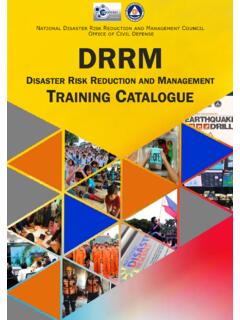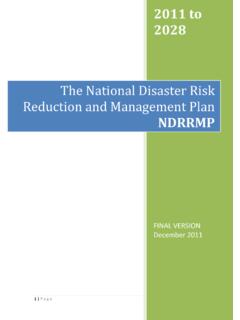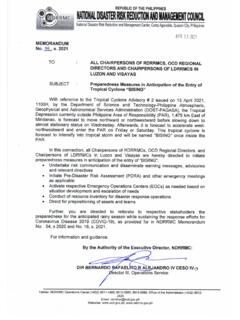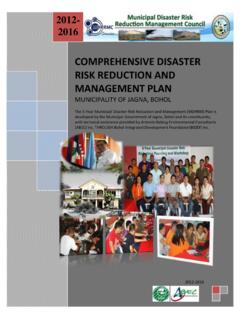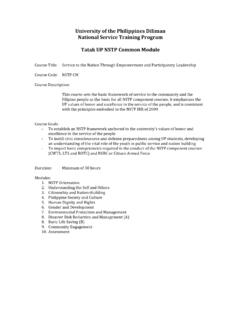Transcription of Climate change and food security: risks and responses
1 Climate change and food security: risks and responses Climate change and food security: risks and responses FOOD AND AGRICULTURE ORGANIZATION OF THE UNITED NATIONS | 2015. Climate change AND FOOD SECURITY: risks AND responses . The designations employed and the presentation of material in this information product do not imply the expression of any opinion whatsoever on the part of the Food and Agriculture Organization of the United Nations (FAO) concerning the legal or development status of any country, territory, city or area or of its authorities, or concerning the delimitation of its frontiers or boundaries.
2 The mention of specific companies or products of manufacturers, whether or not these have been patented, does not imply that these have been endorsed or recommended by FAO in preference to others of a similar nature that are not mentioned. The views expressed in this information product are those of the author(s) and do not necessarily reflect the views or policies of FAO. ISBN 978-92-5-108998-9. FAO, 2015. FAO encourages the use, reproduction and dissemination of material in this information product. Except where otherwise indicated, material may be copied, downloaded and printed for private study, research and teaching purposes, or for use in non-commercial products or services, provided that appropriate acknowledgement of FAO as the source and copyright holder is given and that FAO's endorsement of users' views, products or services is not implied in any way.
3 All requests for translation and adaptation rights, and for resale and other commercial use rights should be made via or addressed to FAO information products are available on the FAO website ( ) and can be purchased through ii Contents Acronyms v Acknowledgments vii Summary ix INTRODUCTION 1. A. Climate change IMPACTS ON FOOD SECURITY: OVERVIEW OF LATEST. KNOWLEDGE 3. Main Climate changes of importance for the agriculture sectors 3. Impacts on agro-ecosystems 8. Crops 8. Livestock and pastoral systems 11. Forests 15.
4 Fisheries and aquaculture systems 16. Genetic resources 17. Economic and social consequences 19. Vulnerabilities determine the importance of the net impact on food security and nutrition 24. Impacts on food security and nutrition 29. Conclusions 34. B. ENSURING FOOD SECURITY AND GOOD NUTRITION IN THE CONTEXT. OF Climate change : OPTIONS AND LESSONS LEARNED 35. Increase resilience of livelihoods 36. Devise appropriate social protection strategies 37. Address gender-related vulnerabilities 40. Conceive disaster risk reduction for food and security and nutrition in the context of Climate change adaptation 41.
5 Build resilience of agricultural systems 42. Crop systems 42. Livestock and pastoral systems 45. Forests 49. Fisheries and aquaculture systems 53. Building resilience at landscape level 55. Managing genetic resources 57. Investing in resilient agricultural development 60. Promoting agricultural development for economic growth, alleviation of poverty and reduction of vulnerabilities in rural areas, focusing on smallholder agriculture 61. Enabling in-farm and off-farm diversification 63. Investing in systems to assess risks , vulnerabilities and adaptation options 64.
6 Enabling adaptation through policies and institutions 69. Building institutions and policies to support the transition to more resilient systems 70. Enhance markets and trade's contribution to stability of food security 73. Strengthen regional and international cooperation 76. iii Climate change AND FOOD SECURITY: risks AND responses . ACTING NOW ON Climate change , TO ENSURE FOOD SECURITY. FOR ALL, NOW AND IN THE FUTURE 81. REFERENCES 83. iv Acronyms AgMIP Agricultural Model Intercomparison and Improvement Project AMIS agricultural market information system ASIS Agricultural Stress Index System (FAO).
7 BPACC Bonne Pratique Adaptation au Changement Climatique (Best CCA practices introduced by the project). CAC Central American Agricultural Council CATIE Center for Tropical Agricultural Research and Higher Education CAU China Agricutural University CBSUA Central Bicol State University of Agriculture CCA Climate change adapation CEPAL Economic Commission for Latin America and the Caribbean CCAFS Research Program on Climate change , Agriculture and Food CFS Committee on World Food Security CGIAR Consultative Group on International Agricultural Research CIAT International Center for Tropical Agriculture CIRAD Agricultural Research for Development CMIP6 Coupled model intercomparison project CORDEX3 Coordinated Regional Climate Downscaling Experiment CPPs Country Programming Papers CSA Climate -smart agriculture DA Department for Agriculture DAD-IS Domestic Animal Diversity Information System DLIS Desert Locust Information Service DRR disaster
8 Risk reduction DRRM disaster risk reduction and management EAF/EAA ecosystem approach to fisheries and aquaculture ENSO El Ni o-Southern Oscillation EEZs exclusive economic zones FAO Food and Agriculture Organization of the United Nations FFS farmer field schools GDP gross domestic product GHG greenhouse gas GIEWS Global Information and Early Warning System on Food and Agriculture GIS geographic information systems HLPE High Level Panel of Experts on Food Security and Nutrition ICEM International Centre for Environmental Management ICTs information and communications technologies IDDRSI Drought disaster Resilience and Sustainability Initiative (IGAD).
9 V Climate change AND FOOD SECURITY: risks AND responses . IFAD International Fund for Agricultural Development IFPRI International Food Policy Research Institute IGAD Intergovernmental Authority on Development IICA Inter-American Institute for Cooperation on Agriculture IMFN International Model Forest Network INDCs intended nationally determined contributions IPCC Intergovernmental Panel on Climate change IPPC International Plant Protection Convention IPPM Integrated Pest Management Programme IUCN International Union for Conservation of Nature LDC least developed
10 Country MAF Ministry of Agriculture and Forestry ME metabolizable energy MOSAICC Modelling System for Agricultural Impacts of Climate change NANOOS Northwest Association of Networked Ocean Observing Systems NAPs national adaptation plans NAPAs national adaptation plans of action NGO non-governmental organization NPPO National Plant Protection Organization ODA official development aid OTC over-the-counter PACFA Global Partnership for Climate , Fisheries and Aquaculture PAGASA Atmospheric, Geophysical and Astronomical Services Administration (Philippines).










